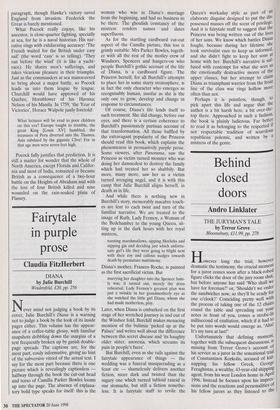Fairytale in purple prose
Claudia FitzHerbert
DIANA by Julie Burchill Weidenfeld, £20, pp. 256 Never mind not judging a book by its cover, Julie Burchill's Diana is a warning not to judge a book by the look of its inside pages either. This volume has the appear- ance of a coffee-table glossy, with familiar snapshots dribbling down the margins of a text frequently broken up by garish double- page spreads. The captions are, for the most part, cosily informative, giving no hint of the subversive vitriol of the actual text. I say for the most part because there is one picture which is revealingly captionless halfway through the book the cut-out head and torso of Camilla Parker Bowles looms up into the page. The absence of explana- tory bold type speaks for itself: this is the woman who was in Diana's marriage from the beginning, and had no business to be there. The ghoulish constancy of the mistress renders names and dates superfluous.
As for the startling cardboard cut-out aspect of the Camilla picture, this too is grimly suitable: Mrs Parker Bowles, togeth- er with all the rest of the motley crew of Windsors, Spencers and hangers-on who people Burchill's gothic account of the life of Diana, is a cardboard figure. The Princess herself, for all Burchill's attempts to place her in some starry stratosphere, is in fact the only character who emerges as recognisably human, insofar as she is the only one to grow, develop and change in response to circumstances.
Of course, Diana's life lends itself to such treatment. She did change, before our eyes, and there is a certain coherence to Burchill's passionately partisan account of that transformation. All those baffled by the extravagant popularity of the Princess should read this book, which explains the phenomenon in persuasively purple prose. Some viewers, after Panorama, saw the Princess as victim turned monster who was doing her damnedest to destroy the family which had treated her so shabbily. But more, many more, saw her as a victim turned avenging angel, and it is with this camp that Julie Burchill aligns herself, in death as in life.
And while there is nothing new in Burchill's story, memorably macabre touch- es are lent to each twist and turn of the familiar narrative. We are treated to the image of Ruth, Lady Fermoy, a Woman of the Bedchamber to the young Queen, sit- ting up in the dark hours with her royal mistress,
toasting marshmallows, sipping Horlicks and nipping gin and deciding just which unfortu- nate girl's life they were going to blight next with their coy and callous nudges towards death by premature matrimony.
Diana's mother, Frances Roche, is painted as the first sacrificial victim. But
marrying her daughter into the Spencer fami- ly was, it turned out, merely the dress rehearsal, Lady Fermoy's greatest plan was just a twinkle in her grandmotherly eye as she watched the little girl Diana, whom she had made motherless, play.
Later, when Diana is embarked on the first stage of her wretched journey in and out of the Windsor fold, Burchill makes menacing mention of the bulimia 'picked up at the Palace' and writes well about the difference between this secret disease and 'its haughty older sister, anorexia, which screams its pain in people's faces'.
But Burchill, even as she rails against the fairytale appearance of things — the wedding was a funeral masquerading as a feast etc — shamelessly delivers another fiction, more dark and twisted than the sugary one which turned tabloid rancid in our stomachs, but still a fiction nonethe- less. It is fairytale stuff to revile the Queen's workaday style as part of an elaborate disguise designed to put the dis- possessed masses off the scent of privilege. And it is fairytale stuff to suggest that the Princess was being written out of the lives of her sons. We know which battles Diana fought, because during her lifetime she took survivalist care to keep us informed, and she didn't fight to keep her sons at home with her. Burchill's narrative is suf- fused with contempt for what she sees as the emotionally destructive mores of the upper classes, but her attempt to claim Diana as triumphant warrior from the front line of the class war rings hollow more often than not.
Perhaps it is pointless, though, to pick apart this life and argue that the author is a bit harsh here, a bit over-the- top there. Approached in such a fashion, the book is plainly ludicrous. Far better to read it as belonging to the respected if not respectable tradition of scurrilous republican polemic, and written by a mistress of the genre.


























































 Previous page
Previous page